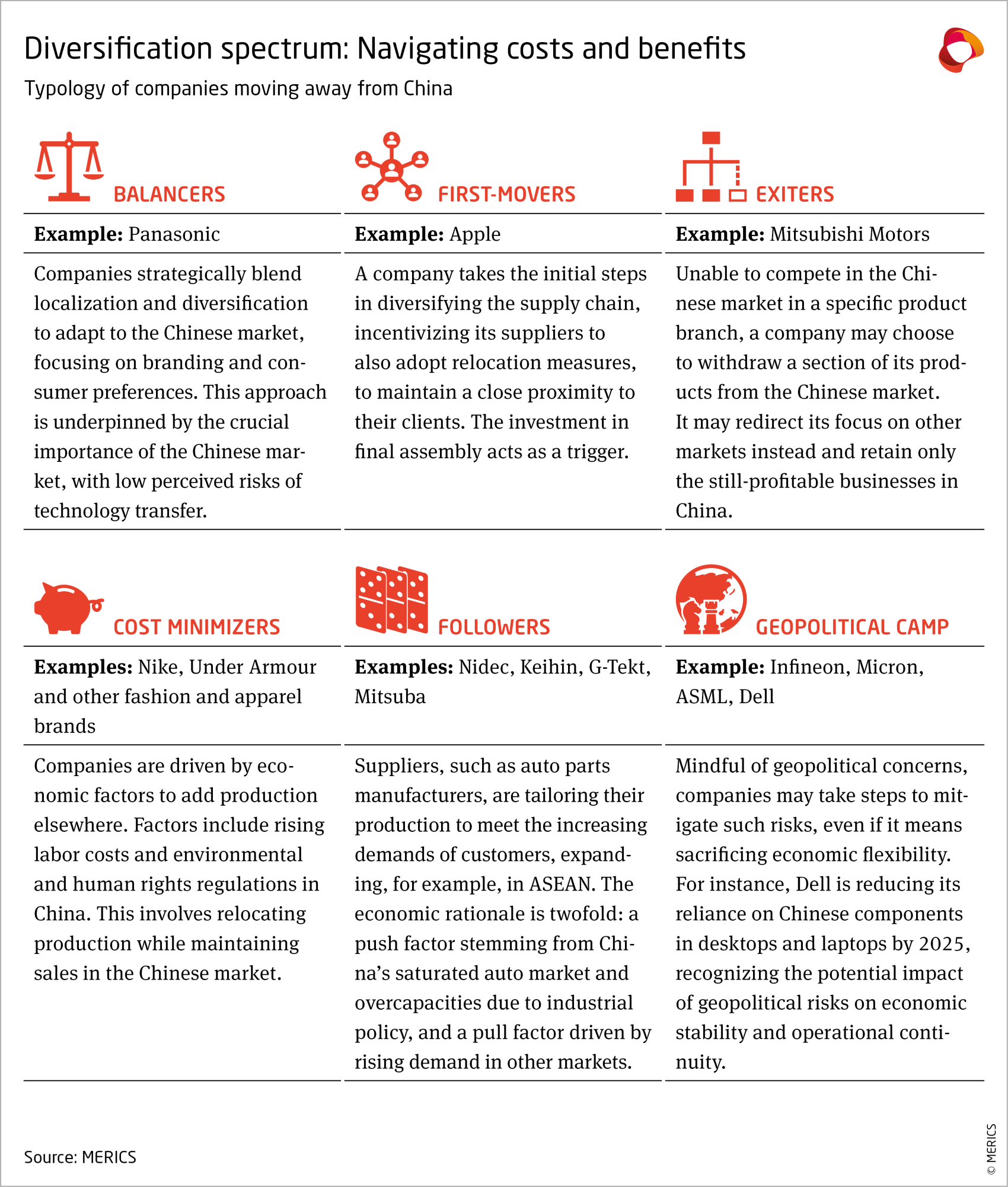

Economic drivers of diversification
Global investment flows show that diversification of foreign investment away from China is taking place. Aya Adachi looks at the different strategies companies have adopted.
In 2023, the European Union's efforts to “de-risk” China relations, to reduce dependencies and risks, have become a key theme. Despite some European companies that continue to onshore to China due to geopolitical tensions and localization pressure, a number appears to be diversifying away from China. They have relocated or added production for exports in other countries and substituted Chinese suppliers, despite claims that it is too costly. These shifts appear to be driven by both geopolitical and economic factors, but often to different degrees and with different outcomes.
Foreign direct investments to China are negative for the first time in decades
Recent surveys suggest that a small but growing share of US, German and European companies have started diversifying their investment and supply-chains. Foreign direct investments (FDI) to China are negative for the first time in decades, with USD 11.8 billion in foreign capital flowing out. Meanwhile, investments to nearby markets have increased, hitting a record of USD 222.5 billion in Southeast Asia in 2022. These shifts underscore that diversification of foreign investment away from China is taking place.
The statistics also show that China's export destinations have evolved as the products it makes have moved up the value chain. Since 2016, China’s export with countries that are not members of the G7 has risen to 60 percent from 46 percent. The export share of intermediary products to non-G7 countries increased from 60 to 69 percent in the same period, indicating that assembly increasingly takes place in third markets. Ties to Chinese companies will likely remain relevant and difficult to disentangle in third markets.
Companies are adopting their own specific diversification strategy. But while individual approaches differ, certain commonalities have emerged. Their approaches vary on the degree to which they want to localize and pursue diversification. The following examples show different economic logics that companies have adopted.
Companies are pursuing various diversification strategies
Companies are adopting various strategies to navigate China's changing economic environment. Powerful first movers, for instance, original equipment makers (OEMs) like Apple have relocated production and encouraged diversification of components. OEMs wield their influence to keep suppliers in close proximity, motivating them to relocate nearby for cost efficiency. Secondly, suppliers like auto-parts manufacturers Nidec and Keihin have pursued economic opportunities propelled by both a “pull” of rising demand in new markets and a “push” of overcapacity in China's auto market.
Balancers, epitomized by Panasonic, navigate the dual imperatives of localization, including branding adjustments in reaction to customer preference, and simultaneous diversification in response to rising risks. Fourthly, market exiters like Mitsubishi Motors strategically are withdrawing from the Chinese market to allocate resources elsewhere. Production cost minimization strategies, pursued by fashion and apparel brands like Nike and Under Armour, are unfolding in response to escalating labor costs and environmental regulations in China.
Finally, non-economic considerations drive entities within the geopolitical camp. Semiconductor and computer producers like Infineon and Dell have recalibrated their dependencies on Chinese components, aware of the intricate nexus between geopolitical uncertainties and economic risks. This and the five other types encapsulate the nuanced strategies essential for navigating the dynamic contours of China's economic evolution.
Diversification is a shared imperative for both Chinese and international companies
Meanwhile, Chinese companies are also pursuing diversification. Domestic political crackdowns, as in the case of Tencent, are prompting companies to explore alternative locations abroad. To circumvent scrutiny there, businesses are strategically using third markets to navigate US restrictions, such as Southeast Asia as a hub to avoid the USA’s Inflation Reduction Act or Singapore to camouflage links to China.
In addition, Chinese suppliers are relocating and aligning their strategies with those of their international customers – for example, Apple suppliers GoerTek and Luxshare. As a result, linkages persist between foreign multinational corporations and Chinese companies in third markets. This interplay underscores a dynamic shift in the global business landscape, with diversification becoming a shared imperative for both Chinese companies and their international counterparts.
Companies’ motivations to diversify are predominantly economic
As businesses decide to diversify, they confront a landscape marked by new prospects and inherent challenges. The substantial influence of heightened competition looms large. While the exploration of new markets may result in new opportunities and finding new local suppliers, enterprises must navigate the intricacies of rivalry not only from fellow diversifying entities but also contend with rising presence of Chinese competitors in third markets.
Diversification inevitably comes with a price tag. Those companies moving out of China in different degrees do so because of various economic considerations to minimize costs. Their motivations are predominantly economic because they cannot afford to do so solely for geopolitical reasons.
Aya Adachi was an analyst in the MERICS economic research team until December 2023.

